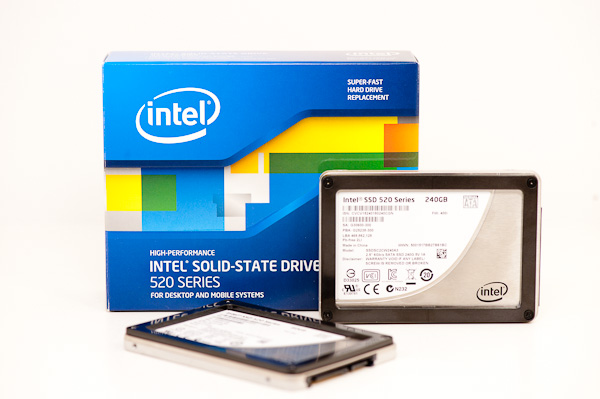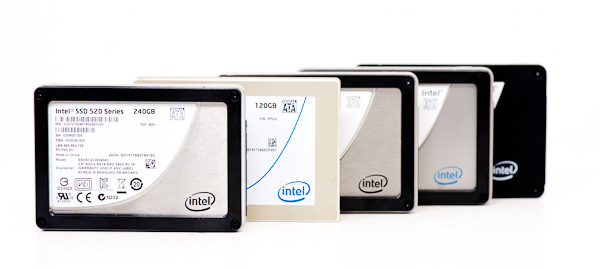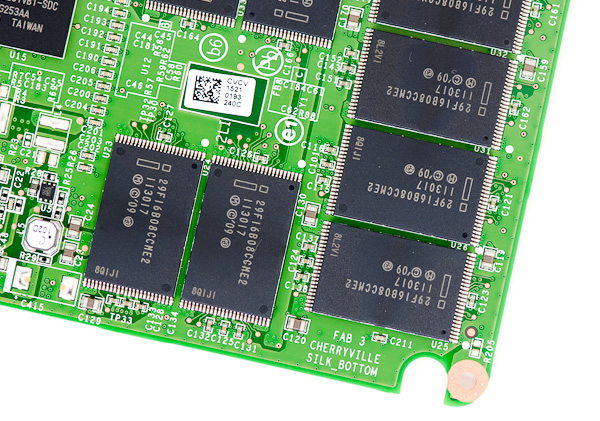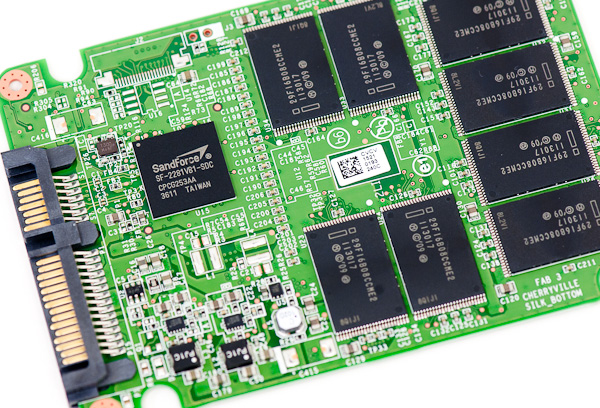Intel SSD 520 Review: Cherryville Brings Reliability to SandForce
by Anand Lal Shimpi on February 6, 2012 11:00 AM ESTIntel was rumored to be working on a SandForce based drive for several months now, but even the rumors couldn't encapsulate just how long Intel and SF has worked on this drive. According to Intel, the relationship began 1.5 years ago. Still lacking a 6Gbps controller of their own and wanting to remain competitive with the rest of the market, Intel approached SandForce about building a drive based on the (at the time) unreleased SF-2281 controller. Roughly six months later, initial testing and validation began on the drive. That's right, around the time that OCZ was previewing the first Vertex 3 Pro, Intel was just beginning its extensive validation process.
Codenamed Cherryville, Intel's SSD 520 would go through a full year of validation before Intel would sign off on the drive for release. In fact, it was some unresolved issues that cropped up during Intel's validation that pushed Cherryville back from the late 2011 release to today.
Intel's strenuous validation will eventually make SandForce's drives better for everyone, but for now the Cherryville firmware remains exclusive. Intel wouldn't go on record with details of its arrangement with SandForce, but from what I've managed to piece together the Intel Cherryville firmware is exclusive for a limited period of time. That exclusivity agreement likely expires sometime after the SF-2281 is replaced by a 3rd generation controller. There are some loopholes that allow SandForce to port bug fixes to general partner firmware but the specific terms aren't public information. The important takeaway is anything fixed in Intel's firmware isn't necessarily going to be fixed in other SF-2281 based drives in the near term. This is an important distinction because although Cherryville performs very similarly to other SF-2281 drives, it should be more reliable.
As Intel has been working on this firmware for quite a while, it's likely that the 520 uses an older branch of the SF-2281 firmware that has been updated over the past twelve months.
The BSOD is Back, but Not on Intel
Back in October SandForce announced that it had discovered a firmware issue that resulted in unexpected BSODs on SF-2281 drives on certain platforms. Why it took SandForce several months to discover the bug that its customers had been reporting for a while is a separate issue entirely. SandForce quickly pushed out the firmware to OCZ and other partners. Our own internal testing revealed that the updated firmware seemed to have cured the infamous BSOD.
Just as background, our SSD testing is rarely over once the review goes live. Any drive we recommend gets tossed into a primary use machine somewhere within the company. We keep track of drive behavior, including any bugs or performance issues over time. This long term testing process takes place over months. The results of these long term tests are folded into future reviews and recommendations.
The BSOD is caused by a bug in SandForce's power state logic that ultimately results in the drive disconnecting from the system while it's running. It turns out that Windows isn't a fan of you hot un-plugging the drive it's running on, which results in the BSOD. We had two systems that exhibited the BSOD, both of which were fixed by the update last October.

As luck would have it, our own Brian Klug happened to come across an unexpected crash with his 240GB non-Intel SF-2281 based SSD two weeks ago when he migrated it to another machine. The crash was an F4 BSOD, similar in nature to the infamous BSOD issue from last year. While two of the systems we reproduced the BSOD bug on were cured by last year's firmware update, Brian's system (an X58/Core i7 build) was BSODing regularly playing Battlefield 3. Games end up being a great way to trigger the SF-2281 BSOD issue as they frequently switch between periods of idle and load, which does a good job of stressing the power state logic in SandForce's firmware. I immediately sent Brian an Intel SSD 520 to see if the BSOD remained on Intel's drive. Switching to Cherryville caused Brian's BSODs to go away. Indeed most end user reports of SF-2281 BSODs went away with the fixed firmware, but we've still heard of isolated issues that remain unresolved. Whatever Intel has done with the 520's firmware seems to have fixed problems that still remain in the general SF-2281 firmware.
This is actually a dangerous precedent as it means one of two things. The first possibility is that SandForce has been made aware of flaws in its current firmware and chooses against (or is legally prevented from) disclosing it to its partners. The second possibility, and arguably even worse for SandForce, is that Intel was able to identify and fix a bug in the SF-2281 firmware without SandForce knowing it existed or was addressed. I suspect it's the former but as no one is willing to go on the record about the Intel/SandForce agreement I can't be certain.
Intel did go on record saying that the 520 is expected to have far fewer F4/F7 BSODs than any other SF-2281 drive. I asked Intel if I should read into the phrase "far fewer", but the answer was no - the 520 is expected to have similar reliability to the Intel SSD 510 and 320.
At the end of the day that's what Intel really brings to the table with the 520. As you'll soon see, performance isn't very different compared to other SF-2281 based drives. Intel's biggest advantage comes from the unique firmware that ships with the drive. Intel is also quick to point out that while other SF-2281 manufacturers can purchase the same Intel 25nm MLC NAND used on the 520, only Intel's drives get the absolute highest quality bins and only Intel knows how best to manage/interact with the NAND on a firmware level. While it's nearly impossible to prove most of this, the fact that we're still able to reproduce a BSOD on the latest publicly available SF-2281 firmware but not on the SF-2281 based Intel SSD 520 does say a lot about what you're paying for with this drive.
And you are paying a premium for the 520 compared to other SF-2281 based SSDs on the market today:
| Intel SSD 520 Price Comparison | |||||||
| 60GB | 120GB | 180GB | 240GB | 480GB | |||
| Intel SSD 520 (SF-2281) | $149 | $229 | $369 | $509 | $999 | ||
| Kingston HyperX (SF-2281) | N/A | $205 | N/A | $420 | N/A | ||
| OCZ Vertex 3 (SF-2281) | $95 | $190 | $240 | $375 | $850 | ||
| Samsung SSD 830 | $110 | $220 | N/A | $360 | $800 | ||
Last year Intel hinted at a move from the consumer market to enterprise server and client markets. The 520's higher price likely won't matter there, but for consumers the higher price is noticeable - particularly with good options from companies like Samsung now available on the market.














138 Comments
View All Comments
vanteo - Thursday, May 31, 2012 - link
I got a 520 120 GB for my Lenovo W520 a week ago ($187). I experienced a few freezes (mouse still movable but the HD light stuck on and I couldn't actually DO anything), and long stutters (5 sec < n < 1 min) while setting it up shortly after Windows 7 64-bit install. It came with the 400i firmware, which was still the latest. As I used it more, the freezes have stopped and the stutters seem to have all but disappeared. I did install Intel's latest Rapid Storage Technology drivers at some point, so perhaps that helped. Otherwise, very fast and I'm pleased.vanteo - Thursday, May 31, 2012 - link
I should clarify that the problems were during normal operation. They had nothing to do with hibernate, standby, or resume.vanteo - Thursday, August 23, 2012 - link
Update: I'm still running into these hangs regularly, actually. I followed some advice to change some advanced Hard disk power options (LMP), but that had no effect. Either it's a bad drive, or there's some system incompatibility with the Lenovo ThinkPad W520.kzinti - Thursday, May 31, 2012 - link
Just following up on my April 18 post... I am still running the replaced 520 SSD as my OS and everything runs smoothly. Haven't run into a single BSOD or hiccup / slowdown. I use my computer 4h+ a day.jfgreen - Monday, September 17, 2012 - link
This drive has some serious issues this was my post in Intel Support Community:Last Thursday I received my brand new Dell Precision M6600. Before I started to use the system I upgraded the hard drive to an Intel 520 Series..
After dropping in the SSD, I was ready to install Windows 7 Pro. I first went into the BIOS and left the setting on RAID. After reading tons of forums, this seemed like the right way on installing the hard drive. Once complete I installed all the necessary drivers (which is a story in its self!). After, I went on the Intel website and ran the driver utility make sure everything is up-to-date. I also installed the SSD toolbox to optimize the drive.
After dealing with the BIOS not always detecting the SSD and the occasional OS freeze, I made my way into the Intel control panel. I noticed the hard drive was only running at 3GB/s, I thought that was kind of odd since the computer is capable of running 6GB/s. I decided to change the BIOS to AHCI and reinstall 7..
Once complete, I still had to deal with the BIOS not detecting the SSD and 7 freezing up, every so often. Anywho, once I re-installed all drivers and utilities. I now see the hard drive running at 6GB/s. I was a happy camper until I started to use the computer. I noticed it freezed up the more I use it.
Intel (typing this while simultaneously shaking my pointer finger) you have a serious issue with your SSD. You need to post a firmware update. Not only to fix the issue with 7 but, also for folks who have M6600 and other affected laptop/desktops; who decide to buy your SSD.
nextel2010 - Saturday, September 29, 2012 - link
I hear you. I purchased three Intel 520's and installed them in three systems known to be stable. One works well, one had intermittent freezes, and the last would freeze and BSOD several times a day, regularly. This last one also had problems being recognized by the BIOS during installation, and would intermittently drop off the system afterwards.I researched the issue, and found a whole lot of suggested fixes, but no general patterns to a solution. In an effort to troubleshoot the last system, I replaced the 520 with an old OCZ Core II, purchased in early 2009. The OCZ was recognized immediately by the BIOS, and installed easily. It ran perfectly, if a bit slower, up to the present time (more than a month).
i don't have time to troubleshoot the two nonworking systems, which are mission-critical and needed to be operational, so I returned the two troublesome 520's and replaced them with Samsung 830's. The Samsungs are lifesavers. They work perfectly, are every bit as fast as the Intels and, most importantly, are rock stable. I couldn't be happier with them or recommend them more. Adding even more value is the fact that the Samsungs were less expensive than the 520's.
I initially went with the Intel because of their five-year warranty and reputation for reliability, but to me at least, it doesn't appear that they have been able to iron out the issues with the SF-2281. To date, no firmware update had been released. A longer warranty for a troublesome drive is pointless. A lot of users have had no issues with the 520's, but a good number still encounter problems. If it was my own system and time wasn't an issue, I wouldn't mind tinkering and troubleshooting, but under the circumstances, I simply went with the solution that works.
toncij - Sunday, September 30, 2012 - link
It is a nice review, but what bothers me is:"Intel did go on record saying that the 520 is expected to have far fewer F4/F7 BSODs than any other SF-2281 drive. I asked Intel if I should read into the phrase "far fewer", but the answer was no - the 520 is expected to have similar reliability to the Intel SSD 510 and 320."
Since I've experienced 320 series and would never go back there, I wonder why intel avoids to say "NO BSODs" - I'm not particullary fond of "far fewer BSOD's" and I prefer zero of those.
I'm looking for the best SSD I can get, but with stability and reliability being a primary variable to look at. I've noticed people praise SM 830 drivers, but these seem much slower than 520 and still quite power-hungry at idle and load, which pretty much is not what I'd like to put into my ultraportable.
Is Intel still prone to BSODs and how good it really is compared to SM830?
sarangiman - Friday, October 12, 2012 - link
Not sure why this article mentions that the 480GB drive is only available with a 9.5mm chassis.If you remove the black spacer, it's 7mm (well, 6.5mm as measured by my caliper).
Albeit, I just bought the drive this week (10.2012); was this 480GB drive originally 9.5mm but now they're shipping 7mm chassis + black spacer?
If one could find short screws for the 7mm chassis, I don't see why one couldn't use the 480GB drive in form factors requiring 7mm drives...